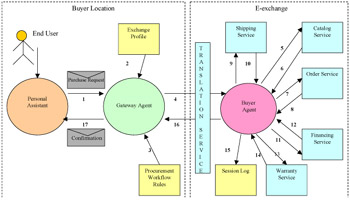Transaction Flows
|
There are various types of transactions supported by an e-exchange such as: registration, catalog updates, catalog queries, purchase order, purchase order acknowledgment, purchase request, auction request, RFP/RFQ, basket deals, bartering, order status, invoices, financing, partial shipment, back orders, settlement, warranty & maintenance, schedule delivery, and returns and incorrect shipment. Readers can refer to Phillips and Meeker (2000) for a detailed description of exchange transactions. In order to illustrate the interaction of various agents, transaction flows associated with two common transactions are presented. In the examples presented below, the communication service is not shown as we implicitly assume that any communication between various entities will involve communication service.
Catalog Queries
This transaction is generated when a user wants to get item-price information. The query steps (as illustrated in Figure 6) are as follows:
-
The personal assistant sends a query message for a single item to the gateway agent.
-
The gateway agent then routes the request to the e-exchange based on the workflow rules. (It is assumed that prior to this transaction, the personal assistant has successfully logged into the e-exchange.)
-
The translation service at the e-exchange receives the query in a format such as X.12 and then translates the message into the XML version of X.12 and encapsulates the XML message within a SOAP message. The SOAP message has all the routing information added. The SOAP message (similar to the message in Figure 4) is then sent to the buyer agent.
-
The buyer agent uses embedded workflow logic to create two query messages in XML within SOAP envelopes. The first message is sent to the catalog service.
-
The buyer agent sends the second query message to the auction service.
-
The catalog service agent checks its internal database for the query item. If the query item can be found in the catalog, then the catalog service sends item records back to the buyer transaction agent.
-
The auction service agent checks its internal database for the query item. If the query item is being auctioned, item records are sent by the auction service.
-
The buyer agent combines the item records received, records transaction information in the session log.
-
The buyer agent then ships the item records to the translation service as an XML message within a SOAP envelope. This message is similar in format to the message in Figure 5.
-
The translation service then converts the XML/SOAP message back to the original X.12 message and then forwards it to the gateway agent for delivery to the personal assistant.

Figure 6: Catalog Query Transaction.
Purchase Request
This transaction is executed when the user requests the purchase of an item. In the transaction flow presented in Figure 7, the buyer transaction agent makes the decision to purchase an item at a particular price. The transaction steps are as follows.

Figure 7: Purchase Request Transaction.
-
The personal assistant sends the purchase request to the gateway agent.
-
The gateway agent obtains the exchange profile information.
-
The gateway agent then accesses the workflow authorization rules and then filters or forwards the purchase request based on the workflow authorization rules.
-
The purchase request in the X.12 format for instance, is received by the translation service, which then translates the received message to the XML version of X.12 format and then puts it in a SOAP envelope. The SOAP envelope is then forwarded to the buyer agent.
-
The buyer agent then sends a query to the catalog service to identify the suppliers for the item to be purchased.
-
The catalog service returns a message with the item records that also include supplier ID.
-
The buyer agent, depending on the workflow rules can either select a supplier having the minimum cost or negotiate with suppliers via the order service that can act as an intermediary.
-
In case of negotiations, the order service returns the negotiated issue values.
-
If an agreement is reached, then based on the workflow rules, the buyer agent may then contact the shipping service for locating the shipper with the least cost.
-
Using the reverse auction facility available at the shipping service, an agreement is reached with a shipper.
-
The buyer agent then contacts the financing service to locate a finance company willing to finance the transaction at the best possible terms.
-
Again using the reveres auction facility available to the financing service, an agreement is reached with a financing company.
-
The buyer agent then contacts the warranty service to locate a warranty at the cheapest possible price for the coverage required.
-
An agreement is then reached with the warranty company again using RFP.
-
The entire transaction is then recorded in the Session Log.
-
The buyer agent then sends transaction information to the gateway agent.
-
The gateway agent then sends the purchase order confirmation to the personal assistant.
|
EAN: 2147483647
Pages: 195